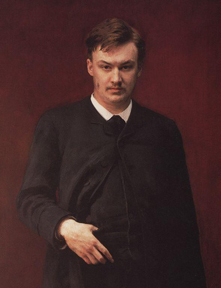

Aleksandr Konstantinovich Glazunov (1865-1936) composed Elégie for Viola and Piano in G minor, Op. 44 in 1893. Glazunov was a Russian composer who combined serious Russian nationalism with European international styles. He began taking piano lessons when he was nine, and started composing music when he was 11. When he was 14, he began studying composition privately with the renowned Russian composer Nikolay Rimsky-Korsakov, and although Glazunov was 21 years younger than Rimsky-Korsakov, they developed a lifelong friendship. Glazunov joined Rimsky-Korsakov in numerous musical ventures, such as completing and revising Borodin's unfinished compositions.
In 1899, Glazunov was appointed as a professor at the Saint Petersburg Conservatory. He remained associated with the conservatory for the next 30 years, and was appointed director of the conservatory in 1905. In 1922, Glazunov was awarded the Russian honor: People's Artist of the Republic. Although he composed some stage and vocal works, Glazunov is primarily known for his instrumental compositions which included symphonies, concertos, orchestral music, ballet music and chamber music. [29]

TECHNIQUE TIPS: Glazunov's Elégie for Viola and Piano is in the key of G minor. Minor keys are sometimes used by composers to evoke a slightly sad feeling, and Glazunov's use of a minor key adds to the sweet sadness of his poignant melody. The form of this piece is an elegy, and this term is used to describe a poem or instrumental piece that laments the loss of someone who has died. The musical direction dolce is placed at the beginning of the piece, meaning play the piece sweetly. The melody begins on an upbeat (start with an up-bow). The tempo of this piece is allegretto, indicating a moderately fast tempo should be used, and the meter is in 9/8. A 9/8 meter means there are nine eighth notes in each measure, and the eighth notes are grouped into a strong triple pulse in each measure (ONE-two-three, FOUR-five-six, SEVEN-eight-nine).
© Copyright 2025 RK Deverich. All rights reserved.
Although this online violin class is provided free of charge, all rights are reserved and this content is protected by international copyright law. It is illegal to copy, post or publish this content in any form, and displaying any of this material on other websites, blogs or feeds is prohibited. Permission is given for individual users to print pages and perform music from this website for their personal, noncommercial use.